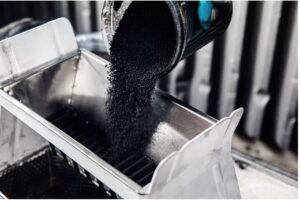Tire Giants Bridgestone and Michelin Publish rCB White Paper
Initiative aims to spark industry dialogue around the use of recovered carbon black
Bridgestone and Michelin are pushing for increased use of recovered carbon black (rCB) in tire production, according to their joint white paper released last month. Currently, less than one percent of global carbon black in new tires comes from recycled end-of-life tires, an amount the companies aim to increase to dramatically reduce CO2 emissions. The initiative isn’t merely about investment, it’s about sparking necessary industry dialogue around the use of this recovered material.
Progress in any industrial sector often hinges on the collaborative efforts of its leading players, and the tire industry is no exception. Bridgestone and Michelin, two of the sector’s titans, have committed to a partnership that recognizes the need for sustainability and transcends competition. In an industry first, these companies have come together with a joint white paper, setting a new standard for the use of recovered carbon black from end-of-life tires (ELTs).
Overcoming supply chain challenges
The scale of the issue is immense, with an estimated one billion tires discarded annually. The potential for transformation is equally vast; the white paper suggests that by utilizing rCB, the industry could cut CO2 emissions by up to 85 percent compared to the use of virgin materials. This is not just a marginal improvement but a significant leap towards an environmentally sustainable practice.
One of the primary barriers to the widespread adoption of rCB has been the supply chain challenges. The production of rCB involves complex processes that require high levels of consistency and quality. Bridgestone and Michelin have acknowledged these hurdles and, through their collaboration, have proposed standards and guidelines that could streamline the supply chain.
The joint white paper details the collaborative efforts with rCB suppliers to ensure the material meets the necessary specifications. The white paper indicates that the companies have produced a set of definitions, proposed specifications, and guidelines for regulatory requirements – a foundational step towards creating a sustainable rCB industry.
Regulatory compliance and safety
While the environmental benefits of rCB are clear, regulatory compliance and safety considerations remain paramount. The joint effort by Bridgestone and Michelin addresses such concerns, outlining the importance of adhering to various global regulations such as TSCA, REACH, and waste regulations. These standards are crucial for the safe and sustainable use of rCB in the tire manufacturing process. Manufacturers and suppliers must ensure that rCB is not only effective but also safe for use and compliant with environmental, health, and safety (EHS) regulations.
 Additionally, the white paper addresses the potential for hazardous substances in rCB composition. It urges manufacturers to strive to eliminate such substances and maintain them below regulatory thresholds. This approach not only safeguards health and the environment but also reinforces consumer confidence in the quality and safety of recycled materials.
Additionally, the white paper addresses the potential for hazardous substances in rCB composition. It urges manufacturers to strive to eliminate such substances and maintain them below regulatory thresholds. This approach not only safeguards health and the environment but also reinforces consumer confidence in the quality and safety of recycled materials.
Aiming for a circular economy
Both Bridgestone and Michelin have ambitious sustainability targets. Bridgestone aims to manufacture products from 100 percent sustainable materials by 2050, while Michelin has set its sights on achieving 40 percent recycled and renewable materials in their tires by 2030. This joint initiative forms a critical part of their strategies to reach these goals and demonstrates a commitment to transitioning from a linear value chain to a circular one.
The collaboration extends to technological advancements as well. Michelin has partnered with Enviro Scandinavian Systems to industrialize innovative pyrolysis technology, which breaks down tires at the end of their life to recover carbon black, among other materials. Meanwhile, Bridgestone has invested in Delta Energy Group, a leader in material recovery from ELTs, showing its commitment to scaling up this technology.
Global implications and future prospects
The implications of the white paper’s guidelines extend far beyond the companies’ individual sustainability targets. They represent a potential shift in the entire industry towards a more sustainable and environmentally responsible future. The focus markets for this phase were Europe and North America, but the principles of the work can be scaled globally, paving the way for a universal standard in tire production.
Bridgestone and Michelin expect the rCB market to grow significantly, reaching up to 1 million tons by 2030. This growth is contingent not only on the quality and performance improvements of rCB but also on the industry’s willingness to adopt the proposed standards and to engage in continued R&D efforts.
Engagement with various stakeholders has been a cornerstone of this initiative. The companies recognize that achieving a circular tire economy is not a task that can be accomplished in isolation. Marco Musaio, Head of End-of-Life Tyre & Circular Economy at Bridgestone Europe, emphasized the need for collaboration within the industry to create a sustainable and circular tire economy.
Fabien Gaboriaud, Senior Vice President of Sustainable Materials & Circularity at Michelin, also highlighted the paradigm shift from linear to circular value chains. The partnership between Bridgestone and Michelin, along with the active involvement of rCB suppliers and other stakeholders, is indicative of the industry’s readiness to embrace this change.
Driving towards a greener future
The joint white paper is more than a set of guidelines; it’s a call to action for the entire tire industry. With two of its largest companies leading the charge, the industry is poised to make significant strides in sustainability.
Source: Team IO, Innovations Origins. Used with permission
© Scrap Tire News, December 2023






